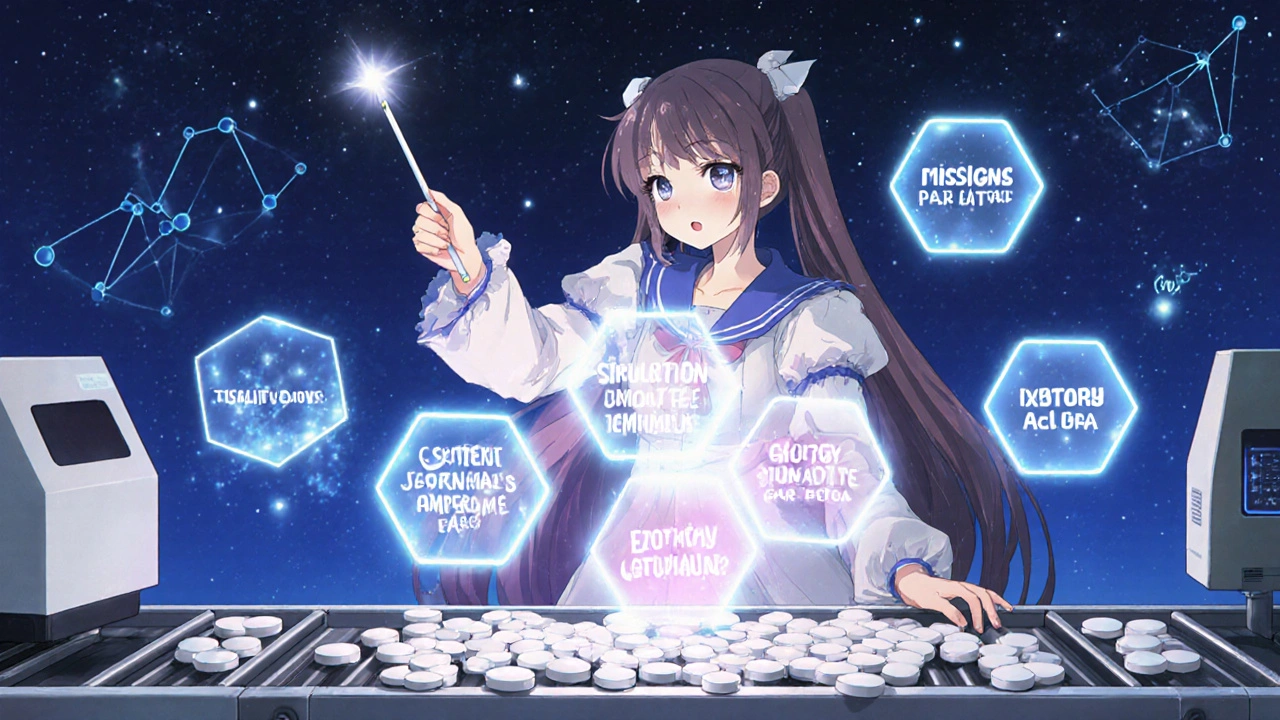 Nov, 20 2025
Nov, 20 2025
What Quality by Design (QbD) Really Means for Generic Drugs
For years, making a generic drug meant copying the brand-name version as closely as possible-same active ingredient, same dose, same pill shape. But Quality by Design changed all that. It’s not about copying anymore. It’s about understanding why the drug works the way it does, from the first granule to the final tablet. The FDA and other global regulators now expect this level of scientific rigor in every Abbreviated New Drug Application (ANDA) submitted after October 2017. If you’re developing a generic, you can’t just test the finished product and hope it matches the original. You have to build quality into every step of the process, from the start.
The Core of QbD: From Testing to Understanding
Traditional generic development treated manufacturing like a recipe. Mix for 15 minutes. Compress at 12 kN. Dry at 45°C. If the batch failed, you blamed the operator or the machine. QbD flips that. It asks: What happens if the moisture content goes to 3.2%? What if the compression force drops to 9 kN? The answer isn’t ‘it might fail’-it’s ‘we tested 120 variations and know exactly how each parameter affects dissolution and impurity levels.’ This is the heart of QbD: using science to define safe operating ranges, not fixed numbers.
The foundation is the Quality Target Product Profile (QTPP). This document lists everything the drug must do: dissolve at the right rate, stay stable for 36 months, have less than 0.15% of a certain impurity. For a generic, the FDA requires at least 95% similarity to the Reference Listed Drug (RLD) in dissolution profiles. That’s not a suggestion-it’s a hard requirement. From the QTPP, you identify Critical Quality Attributes (CQAs). These are the measurable traits that directly impact safety and effectiveness. For most tablets, that’s dissolution (f2 similarity factor >50), content uniformity (RSD ≤6.0%), and impurity profiles following ICH Q3B limits.
How QbD Works: The Five Key Pieces
QbD isn’t a buzzword. It’s a system with five interconnected parts:
- Quality Target Product Profile (QTPP) - What the drug must achieve.
- Critical Quality Attributes (CQAs) - The measurable traits that matter.
- Critical Process Parameters (CPPs) - The manufacturing variables you control, like granulation time, drying temperature, or compression force. Most products have 3-8 CPPs.
- Design Space - The proven window of operating conditions where quality is guaranteed. This isn’t a guess. It’s based on DoE studies testing hundreds of combinations. The FDA accepts design spaces with 95% confidence that CQAs stay within limits across 100+ simulated batches.
- Control Strategy - How you monitor and manage the process. This includes real-time testing using Process Analytical Technology (PAT), like near-infrared spectroscopy. Companies using PAT reduce end-product testing by 35-60%.
Once you’ve defined these, you don’t need FDA approval every time you adjust a parameter-so long as you stay inside the design space. That flexibility saves companies $1.2-2.8 million per product annually in regulatory filings and process change delays.

QbD vs. Traditional Development: The Numbers Don’t Lie
Let’s compare the old way with QbD:
| Metric | Traditional Approach | QbD Approach |
|---|---|---|
| Average approval timeline | 13.9 months | 9.2 months |
| Complete Response Letters (CRLs) | High frequency | 31% fewer |
| Process robustness during scale-up | Baseline | 28-42% higher |
| Post-approval deviations per year | Up to 14 | As low as 2 |
| First-cycle approval rate (FDA QbD Pilot) | 78% | 92% |
The data is clear. QbD reduces regulatory friction, speeds up approvals, and cuts quality failures. Hikma Pharmaceuticals cut annual quality investigations from $850,000 to near zero after switching to QbD. Mylan (now Viatris) made 11 manufacturing adjustments to its simvastatin process without prior FDA approval-keeping supply steady during pandemic disruptions.
Where QbD Shines-and Where It’s Overkill
QbD isn’t a one-size-fits-all tool. It’s most powerful for complex generics: extended-release tablets, inhalers, transdermal patches, injectables. These products have tricky bioequivalence challenges. Traditional methods often require costly clinical trials. QbD lets you prove equivalence through in vitro testing-dissolution, permeability, particle size-saving millions.
But for a simple immediate-release tablet with well-known excipients? Over-engineering QbD can be wasteful. Some companies spent $450,000 on DoE studies for products where the design space was already obvious. The FDA and industry experts agree: scale the science to the product. Don’t use a sledgehammer to crack a nut.
Dr. James Polli from the University of Maryland puts it bluntly: ‘Over-engineering QbD for simple generics creates unnecessary burden without commensurate quality benefits.’ The goal isn’t to do the most experiments-it’s to do the right ones.
Implementation Challenges: The Hidden Costs
Yes, QbD saves money long-term. But the upfront cost is real. You need:
- Scientists trained in Quality Risk Management (ICH Q9) and Design of Experiments (80-120 hours each)
- PAT equipment like NIR spectrometers ($500,000 minimum investment)
- Specialized software like MODDE Pro ($15,000 per user per year)
- Time: 4-8 months added to the typical 18-24 month development cycle
And it’s not just money. The European Medicines Agency found that 63% of QbD failures in generics come from poor mechanistic understanding-especially with modified-release products. If you don’t know why a change affects dissolution, your design space is just a guess.
Indian generic manufacturers, facing tighter budgets, adopt QbD at 68% rates-lower than the 89% seen in the U.S. and EU. But the top 10 Indian firms invested $227 million in QbD capabilities in 2022. They know: if you want to compete globally, you need this level of science.

Emerging Trends: The Future of QbD
QbD isn’t standing still. New FDA guidelines like ICH Q14 (Analytical Procedure Development) and Q2(R2) now require more robust method validation-but they reward it with 40% faster approval times for QbD-aligned submissions.
Continuous manufacturing is the next big leap. The FDA’s Emerging Technology Program has approved 27 QbD-based continuous manufacturing applications with 100% success. Teva’s 2022 levothyroxine case study showed 28% better batch consistency using continuous processing with QbD controls.
By 2027, McKinsey predicts 95% of new generic approvals will include QbD. The WHO now includes QbD criteria in its Prequalification Program, meaning global supply chains will demand it. Even low-cost generics aren’t immune-regulators are pushing for proportionate implementation. If your product sells for $10,000 a year, you don’t need a 100-batch DoE. But you still need to prove you understand your process.
What You Need to Get Started
If you’re starting with QbD, here’s the practical path:
- Define your QTPP based on the RLD-don’t skip this step.
- Use risk assessment (ICH Q9) to identify your top 5-12 CQAs.
- Run a Design of Experiments (DoE) to map how CPPs affect CQAs. Start small: 3-5 variables, 2-3 levels.
- Define your design space with statistical confidence (95% is standard).
- Build your control strategy around PAT where possible.
- Use FDA’s free QbD training modules or PDA’s certified courses to upskill your team.
The goal isn’t perfection. It’s confidence. Confidence that your product will work. Confidence that regulators will understand your science. Confidence that your supply won’t break when a machine vibrates or humidity rises.
Final Thought: QbD Is the New Standard, Not the Exception
Quality by Design isn’t a fancy add-on. It’s the baseline for generic drug development in 2025. The FDA, EMA, PMDA, and WHO all require it. The data proves it works. Companies using QbD get faster approvals, fewer recalls, and better margins. The ones still relying on old-school testing? They’re spending more time responding to regulatory questions than making medicine.
It’s not about doing more work. It’s about doing smarter work. Build the science in. Test less. Know more. And deliver better medicines-faster, cheaper, and with fewer surprises.
Is QbD mandatory for all generic drugs?
Yes, for all ANDAs submitted to the FDA after October 1, 2017. While the level of detail can be scaled based on product complexity, regulators expect evidence of scientific understanding, risk assessment, and control strategy in every submission. The EMA and PMDA have similar expectations.
How does QbD improve bioequivalence?
QbD improves bioequivalence by ensuring the generic drug behaves identically to the brand-name product in the body-without always needing clinical trials. Through in vitro testing like dissolution profiling (f2 >50), particle size analysis, and permeability studies, QbD establishes a scientific link between how the drug performs in the lab and how it performs in patients. This replaces guesswork with data-driven equivalence.
What’s the biggest mistake companies make with QbD?
The biggest mistake is treating QbD as a checklist instead of a mindset. Some companies run DoE studies just to check a box, without understanding the underlying mechanisms. If you don’t know why a change in granulation moisture affects dissolution, your design space is meaningless. QbD requires deep scientific insight-not just data collection.
Can small generic manufacturers afford QbD?
Yes, but they need to be strategic. Start with one product. Use FDA’s free training resources. Partner with CROs for PAT equipment. Focus on high-value products where QbD saves the most-complex generics or those with past regulatory issues. Proportionate implementation is key: don’t spend $500,000 on a $2 million/year product unless the ROI is clear.
How long does it take to implement QbD?
For an immediate-release tablet, expect 6-9 months to build the QbD framework. For complex products like extended-release or inhalers, plan for 12-18 months. Training staff and acquiring equipment adds time. But once set up, future submissions are faster and smoother.
Does QbD reduce the need for clinical trials?
Yes, especially for complex generics. Traditional methods often require bioequivalence clinical trials. QbD allows regulators to accept in vitro data-dissolution profiles, permeability, particle size-as proof of equivalence. This cuts development costs by 30-70% and speeds up market entry.
What’s the difference between QbD and traditional quality control?
Traditional quality control tests the final product for compliance. If it fails, the batch is discarded. QbD prevents failure by understanding and controlling the process from the start. It’s like building a car with sensors that adjust the engine in real time-instead of checking the engine only after it’s built.
Are there free resources to learn QbD?
Yes. The FDA offers free QbD training modules through its Center for Drug Evaluation and Research. The Parenteral Drug Association (PDA) provides webinars and certified courses. ICH guidelines Q8(R2), Q9, and Q10 are publicly available and foundational reading.
Sammy Williams
November 22, 2025 AT 03:12Paula Jane Butterfield
November 23, 2025 AT 13:19Swati Jain
November 23, 2025 AT 16:00Shawn Sakura
November 25, 2025 AT 05:03Daisy L
November 25, 2025 AT 13:32Pravin Manani
November 27, 2025 AT 12:51Anne Nylander
November 28, 2025 AT 00:20Noah Fitzsimmons
November 29, 2025 AT 07:53jim cerqua
November 30, 2025 AT 13:40Franck Emma
December 1, 2025 AT 02:38Florian Moser
December 1, 2025 AT 23:23Mark Kahn
December 3, 2025 AT 20:28Eliza Oakes
December 4, 2025 AT 20:31